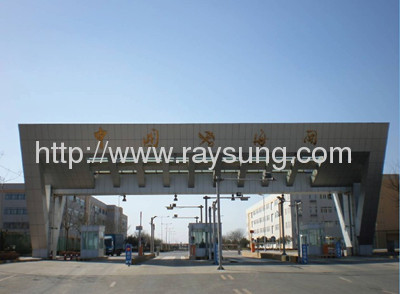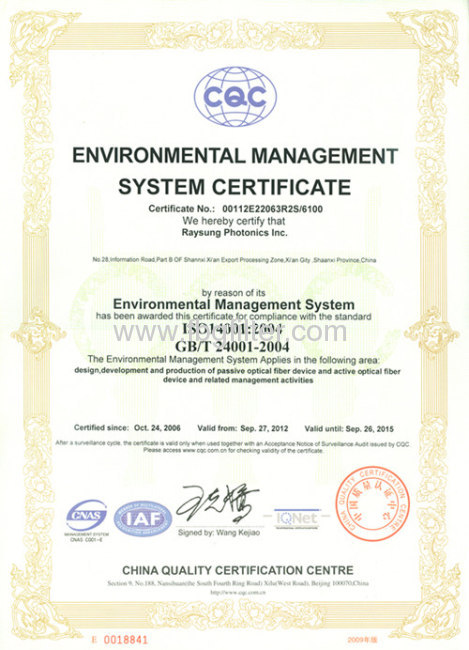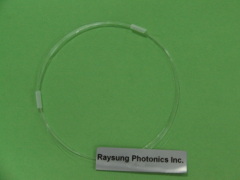
|
Raysung photonics Inc.
|
fiber bragg grating fbg FBG Raysung
| Price: | 80.0~200.0 USD |
| Payment Terms: | T/T,D/A,WU |
| Place of Origin: | Shaanxi, China (Mainland) |
|
|
|
| Add to My Favorites | |
| HiSupplier Escrow |
Product Detail
we can supply 50,000 FBGS per month, we have highly trained employees and many years experience in fabricating fiber bragg gratings.
Types of gratings
The term type in this context refers to the underlying photosensitivity mechanism by which grating fringes are produced in the fiber. The different methods of creating these fringes have a significant effect on physical attributes of the produced grating, particularly the temperature response and ability to withstand elevated temperatures. Thus far, five (or six) types of FBG have been reported with different underlying photosensitivity mechanisms.These are summarized below:
Standard, or type I, gratings
Written in both hydrogenated and non-hydrogenated fiber of all types, type I gratings are usually known as standard gratings and are manufactured in fibers of all types under all hydrogenation conditions. Typically, the reflection spectra of a type I grating is equal to 1-T where T is the transmission spectra. This means that the reflection and transmission spectra are complementary and there is negligible loss of light by reflection into the cladding or by absorption. Type I gratings are the most commonly used of all grating types, and the only types of grating available off-the-shelf at the time of writing.
Type IA gratings
Regenerated grating written after erasure of a type I grating in hydrogenated germanosilicate fiber of all types
Type IA gratings were first observed in 2001 during experiments designed to determine the effects of hydrogen loading on the formation of IIA gratings in germanosilicate fiber. In contrast to the anticipated decrease (or 'blue shift') of the gratings' Bragg wavelength, a large increase (or 'red shift') was observed.
Later work showed that the increase in Bragg wavelength began once an initial type I grating had reached peak reflectivity and begun to weaken. For this reason, it was labeled as a regenerated grating.
Determination of the type IA gratings' temperature coefficient showed that it was lower than a standard grating written under similar conditions.
The key difference between the inscriprion of type IA and IIA gratings is that IA gratings are written in hydrogenated fibres, whereas type IIA gratings are written in non-hydrogenated fibres.
Type IIA, or type In, gratings[edit source | editbeta]
These are gratings that form as the negative part of the induced index change overtakes the positive part. It is usually associated with gradual relaxation of induced stress along the axis and/or at the interface. It has been proposed that these gratings could be relabeled type In (for type 1 gratings with a negative index change; type II label could be reserved for those that are distinctly made above the damage threshold of the glass).
Later research by Xie et al. showed the existence of another type of grating with similar thermal stability properties to the type II grating. This grating exhibited a negative change in the mean index of the fiber and was termed type IIA. The gratings were formed in germanosilicate fibers with pulses from a frequency doubled XeCl pumped dye laser. It was shown that initial exposure formed a standard (type I) grating within the fiber which underwent a small red shift before being erased. Further exposure showed that a grating reformed which underwent a steady blue shift whilst growing in strength.[9][10]
Regenerated gratings
These are gratings that are reborn at higher temperatures after erasure of gratings, usually type I gratings and usually, though not always, in the presence of hydrogen. They have been interpreted in different ways including dopant diffusion (oxygen being the most popular current interpretation) and glass structural change. Recent work has shown that there exists a regeneration regime beyond diffusion where gratings can be made to operate at temperatures in excess of 1,295 °C, outperforming even type II femtosecond gratings.[11] These are extremely attractive for ultra high temperature applications.
Type II gratings[edit source | editbeta]
Damage written gratings inscribed by multiphoton excitation with higher intensity lasers that exceed the damage threshold of the glass. Lasers employed are usually pulsed in order to reach these intensities. They include recent developments in multiphoton excitation using femtosecond pulses where the short timescales (commensurate on a timescale similar to local relaxation times) offer unprecedented spatial localization of the induced change. The amorphous network of the glass is usually transformed via a different ionization and melting pathway to give either higher index changes or create, through micro-explosions, voids surrounded by more dense glass.
Archambault et al. showed that it was possible to inscribe gratings of ~100% (>99.8%) reflectance with a single UV pulse in fibers on the draw tower. The resulting gratings were shown to be stable at temperatures as high as 800 °C (up to 1,000 °C in some cases, and higher with femtosecond laser inscription). The gratings were inscribed using a single 40 mJ pulse from an excimer laser at 248 nm. It was further shown that a sharp threshold was evident at ~30 mJ; above this level the index modulation increased by more than two orders of magnitude, whereas below 30 mJ the index modulation grew linearly with pulse energy. For ease of identification, and in recognition of the distinct differences in thermal stability, they labeled gratings fabricated below the threshold as type I gratings and above the threshold as type II gratings. Microscopic examination of these gratings showed a periodic damage track at the grating's site within the fiber [10]; hence type II gratings are also known as damage gratings. However, these cracks can be very localized so as to not play a major role in scattering loss if properly prepared [12][13]
About Raysung Photonics Inc:
Raysung photonics located in the export processing zone of Xi'an, China, is specialized in manufacturing FBG, lensed fiber and FBG filter for FTTH. Besides those three main products, Raysung can also manufacture wavelength stabilizer, DWDM FBG filter, chirped fiber grating, long period grating, custom fiber grating and so on. In addition, Raysung has ability to develop and produce special gratings for sensor. The company is committed to the research, design and producing of those products and it is the only one manufacture which has the capacity to volume- producing all sorts of fiber grating in China. Moreover, Raysung is one of the only manufactures in the world who has the capacity to manufacture the type of optical fiber which incorporates FBG and lensed fiber. Raysung's products are widely used in aerospace, construction industry, coal industry etc. The company's professional teams have rich experience in photoelectric area and we have advanced technology and equipment. This allows us to provide our customers with high-quality products and optimized proposals.



In 2006, Raysung completed ISO9001: 2000 and ISO14001 certification and also obtained several patent rights. The materials of our products accord with RoHS criterion. Raysung's products are always superior in quality and competitive in price.



















